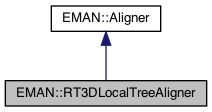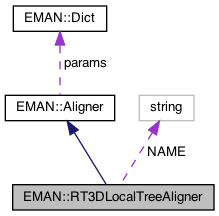3D rotational and translational alignment using a hierarchical method with gradually decreasing downsampling in Fourier space. More...
#include <aligner.h>


Public Member Functions | |
| virtual EMData * | align (EMData *this_img, EMData *to_img, const string &cmp_name="sqeuclidean", const Dict &cmp_params=Dict()) const |
| See Aligner comments for more details. More... | |
| virtual EMData * | align (EMData *this_img, EMData *to_img) const |
| See Aligner comments for more details. More... | |
| virtual vector< Dict > | xform_align_nbest (EMData *this_img, EMData *to_img, const unsigned int nsoln, const string &cmp_name, const Dict &cmp_params) const |
| See Aligner comments for more details. More... | |
| virtual string | get_name () const |
| Get the Aligner's name. More... | |
| virtual string | get_desc () const |
| virtual TypeDict | get_param_types () const |
 Public Member Functions inherited from EMAN::Aligner Public Member Functions inherited from EMAN::Aligner | |
| virtual | ~Aligner () |
| virtual Dict | get_params () const |
| Get the Aligner parameters in a key/value dictionary. More... | |
| virtual void | set_params (const Dict &new_params) |
| Set the Aligner parameters using a key/value dictionary. More... | |
Static Public Member Functions | |
| static Aligner * | NEW () |
Static Public Attributes | |
| static const string | NAME = "rotate_translate_3d_local_tree" |
Private Member Functions | |
| bool | testort (EMData *small_this, EMData *small_to, EMData *small_mask, EMData *small_thissq, vector< float > &sigmathisv, vector< float > &sigmatov, vector< float > &s_score, vector< float > &s_coverage, vector< Transform > &s_xform, int i, Dict &upd, Transform initxf, int maxshift) const |
Additional Inherited Members | |
 Protected Attributes inherited from EMAN::Aligner Protected Attributes inherited from EMAN::Aligner | |
| Dict | params |
Detailed Description
3D rotational and translational alignment using a hierarchical method with gradually decreasing downsampling in Fourier space.
In theory, very fast, and without need for a "refine" aligner. Comparator is ignored. Uses an inbuilt comparison. This variant uses something like FLCF (local cross correlation) for translational alignment, and should work better when the reference is masked but doing this slows things down.
- Parameters
-
sym The symmtery to use as the basis of the spherical sampling verbose Turn this on to have useful information printed to standard out
- Date
- April 2015
Member Function Documentation
◆ align() [1/2]
|
inlinevirtual |
See Aligner comments for more details.
Implements EMAN::Aligner.
Definition at line 1968 of file aligner.h.
References align().
◆ align() [2/2]
◆ get_desc()
|
inlinevirtual |
Implements EMAN::Aligner.
Definition at line 1983 of file aligner.h.
◆ get_name()
|
inlinevirtual |
◆ get_param_types()
|
inlinevirtual |
Implements EMAN::Aligner.
Definition at line 1993 of file aligner.h.
References EMAN::EMObject::BOOL, EMAN::EMObject::FLOAT, EMAN::EMObject::INT, EMAN::TypeDict::put(), EMAN::EMObject::STRING, and EMAN::EMObject::TRANSFORMARRAY.
◆ NEW()
|
inlinestatic |
◆ testort()
|
private |
Definition at line 4296 of file aligner.cpp.
References EMAN::Dict::begin(), EMAN::EMData::calc_ccf_masked(), EMAN::Dict::end(), EMAN::Transform::get_params(), EMAN::Transform::get_trans(), EMAN::Dict::has_key(), EMAN::Transform::inverse(), EMAN::Aligner::params, EMAN::Dict::set_default(), EMAN::Transform::set_params(), and EMAN::Transform::set_trans().
Referenced by xform_align_nbest().
◆ xform_align_nbest()
|
virtual |
See Aligner comments for more details.
Reimplemented from EMAN::Aligner.
Definition at line 3908 of file aligner.cpp.
References EMAN::EMData::calc_ccf_masked(), EMAN::EMData::calc_radial_dist(), EMAN::Symmetry3D::gen_orientations(), EMAN::Factory< T >::get(), EMAN::EMData::get_clip(), EMAN::Aligner::get_params(), EMAN::Transform::get_params(), EMAN::Transform::get_rotation(), EMAN::Transform::get_trans(), EMAN::Dict::has_key(), InvalidCallException, InvalidParameterException, EMAN::Transform::inverse(), EMAN::Transform::invert(), EMAN::Aligner::params, EMAN::Dict::set_default(), EMAN::Transform::set_params(), EMAN::Transform::set_trans(), EMAN::Dict::size(), and testort().
Member Data Documentation
◆ NAME
|
static |
Definition at line 2012 of file aligner.h.
Referenced by get_name().
The documentation for this class was generated from the following files: